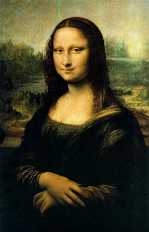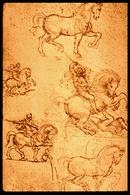 |
| One of many flying marvels |
Leonardo da Vinci was one of the greatest thinkers of his time. He was born April 15th, 1452, in a small farmhouse in Tuscany, Italy. His mother and father were unmarried and that made him illegitimate, so he never got a proper education. Instead, the only education he ever got was from the local church priests, who taught him how to read and write. His father, Ser Piero, was an ambitious young man, who did much of his work in neighboring towns and villages. For the first five years of his life, Leonardo lived with his real mother, Caterina, but for the rest of his childhood, he lived with his father on his estate. But soon his father fell in love with a young, wealthy woman named Albiera di Giovanni Amdori. The two of them moved into the city of Florence, and it was decided young Leonardo would stay in Vinci with his grandparents and Uncle Francesco. Leonardo spent all of his time with his uncle in the fields, learning all the names of the plants and animals that thrived there. It seemed to Leonardo that Francesco knew everything. During this time, Leonardo possibly asked some of his most boggling questions that, later in life, he used for his study.
 |
| Mona Lisa |
At the age of twelve, Leonardo's father realized that his son needed a job. After seeing the wonderful sketches Leonardo drew, he knew what he was destined to do. He grabbed the sketches and carried them to the "bottega" (which is Italian for a studio or workshop) of the famous artist, Andrea del Verrocchio. Once Andrea saw the sketches Leonardo could draw, he immediately signed him up for an apprenticeship. Leonardo was now an official "discepolo," (which is Italian for apprentice). He spent many years learning how to be an artist under the direction of Verrocchio. After many months of doing simple tasks such as sweeping the floor and cleaning the paint brushes, Leonardo was given harder tasks such as polishing statues and grinding pigments to make paint. He started experimenting with colors and shades to get the best out of the colors. He sketched whenever he got the chance and made great pictures. The bottega was a favorite place for artists of the time to come together and discuss their ideas. Soon Verroccho's studio became quite busy and Leonardo was finally allowed to work on small assignments.
Leonardo had such great skills in painting, he soon surpassed all other apprentices. He used calculations in math and geometry to place the lines for drawing and painting in his art. Whenever he had the time, Leonardo would go out and learn from teachers in the fields of science, math, and philosophy. In 1472, Leonardo was twenty years of age and had become a master craftsman of his trade. Everyone now referred to him as Maestro da Vinci, and he was now receiving commissions of his own. When he got the job to paint "The Annunciation," he took what he knew about the wings of birds and put it into his art to make the angel's wings look more realistic.
Even though Leonardo was excellent at his work, he was starting to feel discouraged. He was having trouble getting paid by the monks while his pupils were growing in popularity and getting better commissions. He soon realized that Florence was not the happiest place that he had been. Back at Verrocchio's bottega he'd had a better time and longed for the day that he could return.
In 1485, a huge plague struck Milan and thousands got sick and died. Da Vinci decided to turn to work on disease prevention. Leonardo created ways to widen the streets and dispose of waste properly. He created ways to water the streets and clean them with a system of paddle wheels and locks. In the late 1480s, the plague ended and everyone was ready to celebrate. For helping with the prevention of the plague, Leonardo was now called "pictoret ingeniarius ducalis," meaning top artist and engineer in Latin. Now he had a studio of his own and had a lot of people that wanted to meet him.
 |
| Observation of the skeletal system |
With his own bottega, Leonardo took on five apprentices to help with all the work. He invented and created for his friends and scholars who would laugh at his jokes and listen to his stories and theories. It was during this time that Ludovico wanted a monument created in honor of his father. He wanted a large statue of a bronze horse and rider to show how powerful his family was. Leonardo sketched horses at the stables and watched their movements and how their muscles worked. Although this piece was supposed to be "grandissimo," Leonardo himself never got the chance to finish it. War broke out between Naples, Milan and France, and the bronze was needed for cannons and weaponry. It felt like all the cities in Italy were at war with the French, or with themselves. Even when Leonardo was at the head of weapons and machinery building, he referred to the chaos as "bestialissima pazzia," a bestial madness. Soon after he moved back to Florence to find much had changed. Maestro Verrocchio was dead along with Leonardo's friend, Lorenzo. For a while, he stayed and painted pictures for the monks and townspeople, such as "The Virgin and Child with Saint Anne", or "Saint Jerome." But not long after, in the summer of 1503, he was asked to become a military engineer for the French army. Da Vinci hated the idea of war, so in March of 1503, he made his way back to Florence. Even through all of the madness of war, Leonardo found a commission to paint a battle scene on the wall Palazzo Vecchio to remember the fights between Milan and Florence in the past.
While he was working on the painting in 1504, he was informed that his father was dead. Seeing the battle scene, even unfinished, the French loved his work and invited him back to Milan. Leonardo returned to his beloved city and was greatly welcomed. The lieutenant of the army asked a favor of Leonardo to design a palace to show France's great strength and power. In 1507, Leonardo's Uncle Francesco passed away, and Leonardo needed to return to Florence. He stayed for a long time, to get over his grief. While da Vinci was in Florence, the French became eager for his return. Everybody wanted him to stay in their city and paint them a picture. Leonardo was now fifty-five years old and at the peak of his talent. Just a few years earlier, he painted a picture of a woman on a balcony, mysteriously smiling. He took this painting everywhere with him, kept working on it and perfecting it for many years. He never wrote about the painting in his notebooks, and never wrote down the identity of the woman in the picture. All we know about this mysterious portrait is that Leonardo called it the "La Gioconda," or the "Mona Lisa." Da Vinci cherished the portrait and kept it close to him for the rest of his life.
 |
| The study of Horses - Leonardo |
By 1508, da Vinci was back in Milan as a court painter, engineer, and artistic adviser. He returned to his fascinations with astronomy and mathematics. Even more so, he was interested in the human body. Up to now, Leonardo had dissected over thirty bodies. By this hands-on experience, he was able to discover the disease arteriosclerosis by comparing an old man's body to a child's.
Da Vinci left Milan in 1512, for he was without a patron and a home. After about a year, he was called to Rome by Guiliano Medici to work on the new cathedrals that were being built there with many other talented artists. Unfortunately, the years he spent in Rome were not happy. The Pope forbade Leonardo to carry out his anatomical research. He felt useless and unhappy there. Even during this time he still managed to complete his last work, "Saint John the Baptist," with a smiling Saint John. The new king of France was interested in philosophy, science, and art. He asked Leonardo to come join him in France, where he became the first painter, architect, and engineer of the king. He lived out his life there and was greatly appreciated.
Leonardo displayed heroism by showing that he was not afraid to think beyond what was thought impossible in his time. He showed curiosity, leadership, and compassion in every aspect of his life. He was a very intelligent man who could possibly be a scientist of today, and still be up-to-date on everything. He made so many life-changing inventions that improved the lives of people in his time and ours. Without da Vinci, we probably would not have all the creative and new inventions and ideas that we do today. His discoveries in the fields of mathematics, sciences, astronomy and, most all, his inventions that include the helicopter, diving suite, modern tank, first parachute, airplane, paddle boat, swinging bridge, and even the automobile, have become part of our modern world. And mostly, we take these inventions for granted every day.
Leonardo da Vinci has many hero-like aspects about him. Leonardo showed ingenuity through his inventions, creativity through his art, and perseverance through his long studies of the human body, botany, and nature. Da Vinci was a talented man, yet very humble. He always encouraged other artists and scientists in the ways of new ideas. Leonardo was always curious and questioned everything in his world and beyond. From the time he was young to the day he died, he kept working on his studies and always was thinking.
 |
| Only self-portrait ever found of Leonardo da Vinci |
Leonardo da Vinci died on May 2, 1519, at his home in the Loire Valley in France. He was 67 years old. Before he died, Leonardo had suffered a stroke and had been very ill. He was paralyzed in his right arm and no longer able to paint. But now he could pass on what he knew to his apprentice and friends. Legend has it that Leonardo died in the arms of King Francois.
Leonardo da Vinci was a man of many talents. He could paint in many styles. And it seemed to all those who knew him that he could solve anything and think of the impossible. Leonardo da Vinci is a hero apart from all others.
Page created on 8/2/2015 5:08:16 PM
Last edited 8/26/2018 10:05:33 PM
O'Connor, Barbara. Leonardo da Vinci Renaissance Genius. Minsota: Carolrhoda Books Inc, 2003.
Ripley, Elizabeth . Leonardo da Vinci. USA: Henry Z Walch Inc, 1952.
Herbert, Janis . Leonardo da Vinci for Kids His Life and Ideas . Chicago: Chicago Review Press Inc, 1998.
Christie, Jamie. "Leonardo da Vinci 1452-1519." [Online] Available http://www.yesnet.yk.ca. 3/4/07.
Answers Corp.. "Leonardo da Vinci,artist/scientist." [Online] Available http://www.answers.com.
